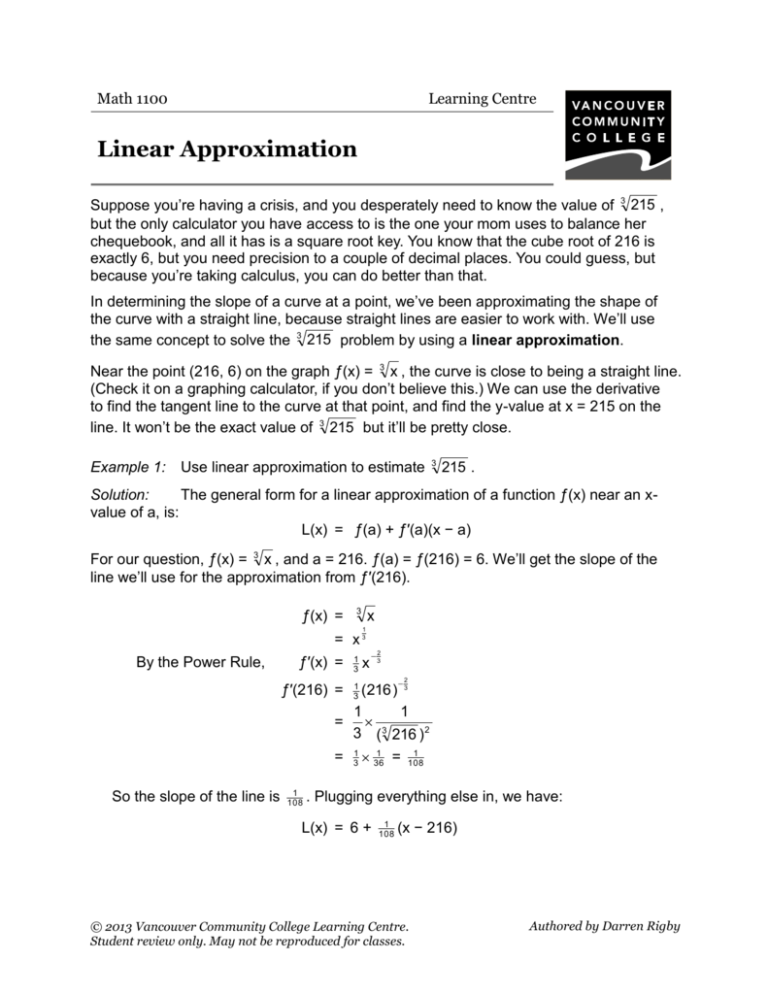Linear Approximation - VCC Library
advertisement

Math 1100 Learning Centre Linear Approximation Suppose you’re having a crisis, and you desperately need to know the value of 3 215 , but the only calculator you have access to is the one your mom uses to balance her chequebook, and all it has is a square root key. You know that the cube root of 216 is exactly 6, but you need precision to a couple of decimal places. You could guess, but because you’re taking calculus, you can do better than that. In determining the slope of a curve at a point, we’ve been approximating the shape of the curve with a straight line, because straight lines are easier to work with. We’ll use the same concept to solve the 3 215 problem by using a linear approximation. Near the point (216, 6) on the graph ƒ(x) = 3 x , the curve is close to being a straight line. (Check it on a graphing calculator, if you don’t believe this.) We can use the derivative to find the tangent line to the curve at that point, and find the y-value at x = 215 on the line. It won’t be the exact value of 3 215 but it’ll be pretty close. Example 1: Use linear approximation to estimate 3 215 . Solution: The general form for a linear approximation of a function ƒ(x) near an xvalue of a, is: L(x) = ƒ(a) + ƒ′(a)(x − a) For our question, ƒ(x) = 3 x , and a = 216. ƒ(a) = ƒ(216) = 6. We’ll get the slope of the line we’ll use for the approximation from ƒ′(216). ƒ(x) = 3 = x By the Power Rule, ƒ′(x) = 1 3 ƒ′(216) = 1 3 = 1 3 x 1 3 x 2 3 2 (216 ) 3 1 1 = 3 ( 3 216 ) 2 So the slope of the line is 1 108 1 36 = 1 108 . Plugging everything else in, we have: L(x) = 6 + 1 108 (x − 216) © 2013 Vancouver Community College Learning Centre. Student review only. May not be reproduced for classes. AuthoredbybyEmily Darren Rigby Simpson Now we just calculate L(215). (Mom’s calculator can at least do that for us.): L(215) = 6 + 215108216 = 5.99074074… Once we’re back home with a real calculator, we can use it to find the exact value for 3 215 , which turns out to be: 5.990726415… Our approximation was correct to four decimal places, and if we rounded, we’d only be off by 1 for the fifth decimal place. The approximation was that good because the curve of y = 3 x is pretty flat in the area near (216, 6), and the number whose cube root we were trying to approximate was close to 216. The choice of a point on which to base the approximation is important. If we used the same line to approximate 3 9 , we’d get 4.0833333… even though we can see that the answer should be close to 2. EXERCISES A. Use the curve ƒ(x) = 1) Evaluate ƒ′(25). x and the point (25, 5) to approximate 30 . 2) Write L(x) for this approximation. 3) Estimate 30 to four decimal places. 4) Use a calculator to find 30 exactly. Is your approximation a good one? Could you have predicted this result before performing the calculation? B. Use the curve ƒ(x) = x and the point (121, 11) to approximate 1) Evaluate ƒ′(121). 120 . 2) Write L(x) for this approximation. © 2013 Vancouver Community College Learning Centre. Student review only. May not be reproduced for classes. 2 120 to four decimal places. 3) Estimate 4) Use a calculator to find 120 exactly. Is your approximation a good one? 5) How can you use your answer to (B3) to improve on your answer to (A3)? C. Estimate the following to four decimal places using an appropriate linear approximation: 1) tan (3 rad) 3) 4 5 [Hint: use 4 80 .] 2) 1 97 4) sin 61° [Hint: you must express the angles in radians.] SOLUTIONS A. (1) 101 (2) L(x) = 5 + 101 (x − 25) (3) 5.5000 (4) 5.4772… Not a very good approximation. This is to be expected because 30 is not very close to 25. B. (2) 221 (2) L(x) = 11 + 221 (x − 121) (3) 10.9545 (4) 10.9545… A very good approximation. (5) Since 120 2 30 we can divide the answer in (B3) by 2 to get a better approximation for 30 : 5.4773… C. (1) ƒ(x) = tan x, at (π, 0): L(x) = 0 + 1(x − π); L(3) = −0.1416 (2) ƒ(x) = 1x , at (100, 0.01): L(x) = .01 − .000 1(x − 100); L(97) = 0.0103 (3) ƒ(x) = 4 80 = 2 4 5 4 x , at (81, 3): L(x) = 3 + 4 5 2.9907... 2 (4) ƒ(x) = sin x, at ( 2π 3 , 1 108 (x − 81); L(80) = 2.9907; =1.4954 3 2 ): L(x) = Actual values: tan 3 = −0.1425…; 1 97 3 2 1 2 (x 2π 3 = 0.0103…; © 2013 Vancouver Community College Learning Centre. Student review only. May not be reproduced for classes. ) ; L(61°) = 4 3 2 1 π 2 180 ( ) = 0.8748 5 = 1.4953…; sin (61°) = 0.8746… 3
![1 = 0 in the interval [0, 1]](http://s3.studylib.net/store/data/007456042_1-4f61deeb1eb2835844ffc897b5e33f94-300x300.png)







